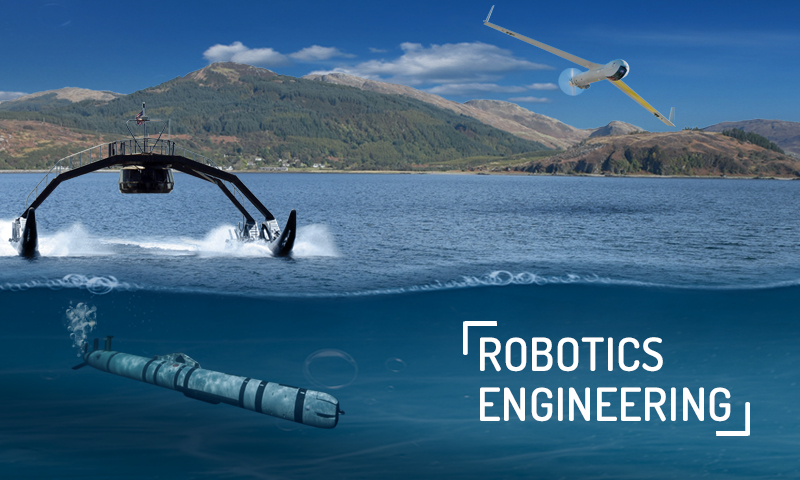The prevalence of unmanned systems across the DOD landscape, and its projected increase, has placed a unique demand on service members and the skills they bring to the fight. In the same way a computer became a core component to almost every defense function, making basic cyber skills core knowledge, leaders are now realizing that a fundamental understanding of robotics and unmanned systems can no longer be the domain of specialists.
Michael Tall, Naval Information Warfare Center (NIWC) Pacific Battlespace Awareness Portfolio Manager, saw the need for robotics engineering skills amongst his peers. Looking for people outside of NIWC with expertise in unmanned systems was turning out to be quite difficult, so Tall thought it made sense to train the interested and nearly-qualified internal workforce.
“I was meeting a lot of talented people in the workforce that didn’t know about unmanned systems, but they know about computer programming, embedded hardware, [etc.],” Tall says. “[I thought] we could teach an introductory class here about unmanned systems, so they could start to make the career switch.”
Tall reached out to NPS Associate Professor Brian Bingham, who agreed to prepare a weeklong deep-dive course on robotics engineering to teach at the NIWC Pacific campus. The course was such a big hit that they had to turn people away. They ended up doing a couple of those courses.
Additionally, Bingham was contacted by Reid McAllister, co-lead of the Unmanned Vehicle and Autonomous Systems (UVAS) Working Group and the director of Integrated Unmanned Maritime Mobility System at the Naval Sea Systems Command (NAVSEA) Carderock division.
“We had been trying for some time to find some type of curriculum that we could send the workforce to within NAVSEA that were interested in autonomy,” McAllister explains. “The natural place would be NPS.”
This budding demand led Bingham to reach out to colleagues across campus to collaboratively design a graduate certificate program. With seed support from the Consortium for Robotics Unmanned Systems Education and Research (CRUSER), the faculty developed the all-new Robotics Engineering Certificate program. The four-class program is offered to any U.S. military officers (both residential and not) and DOD government civilians with a bachelor’s of science in engineering, or a similar field, and experience in computer programming. They hope to offer the opportunity to DOD contractors soon too.
“We’ve found that folks with computer science, applied math and physics degrees are very well prepared for the coursework,” Bingham says.
The program is structured to be a combination of instruction and hands-on activities, so students can properly build the necessary skills. The four classes cover computational and theoretical foundations of robotics as well as component-based software engineering. Each class will be taught by a different NPS professor.
The first half of the curriculum will be foundational, covering important software tools (Matlab and Simulink) and the theoretical foundation for robotics. Students will then dive into the applied physics and data collection. For the hands-on portions of the course, DL students will travel two times to the NPS campus for a week of labs.
Like most programs at NPS, Bingham says the university’s defense-focus make it the perfect university to provide this series of courses because warfighters require a robotics engineering education that is different than the general public.
“For our robotics certificate program, one of the needs we heard from warfare centers is that often they are not building platforms, but instead are responsible for enhancing existing platforms through innovative payloads and missions,” Bingham explains. “This need is distinctively different than the need of self-driving car companies, for example.”
In addition to the DL certificate program, NPS will also provide the program, on-campus version for its resident students. McAllister said that a version of the course will also be offered at Carderock, where more than 20 workforce members eagerly await it.
To make the program as suitable for students as he can, Bingham has coordinated with not just CRUSER professionals, but also experts such as Chris Egan from the Naval Underseas Warfare Center (NUWC) Newport Division, Mark Paulus and David Mortimore from NUWC Keyport Division, and McAllister and Tall, among others. The team designed the program to help practicing engineers refresh their knowledge and skills to orient them towards working efficiently on unmanned systems projects. Tall says that the formal certificate will provide credibility to the skillset, making it easier for job recruiters to know what applicants have learned.
As of now, students attending the course must secure their own financial support for it, but Bingham hopes to eventually offer a “cohort” model, meaning the command will identify the course as essential enough to sponsor a cohort of at least ten students. He and his team are also looking into additional programs to offer along similar lines to robotics engineering, such as robotics operations, machine learning for autonomy, and modeling/simulation for autonomy.
For more information, please visit the Naval Postgraduate School Mechanical and Aerospace Engineering website.


